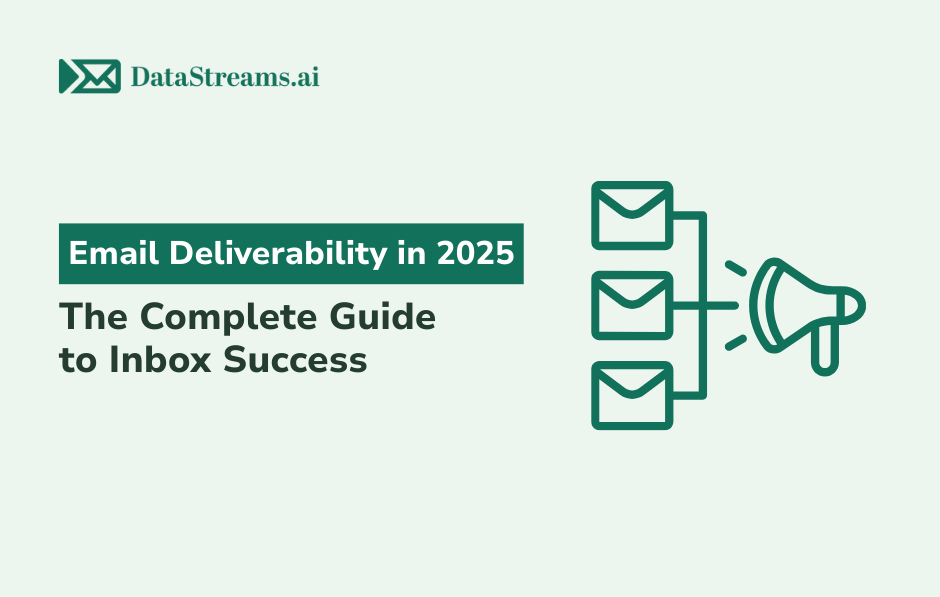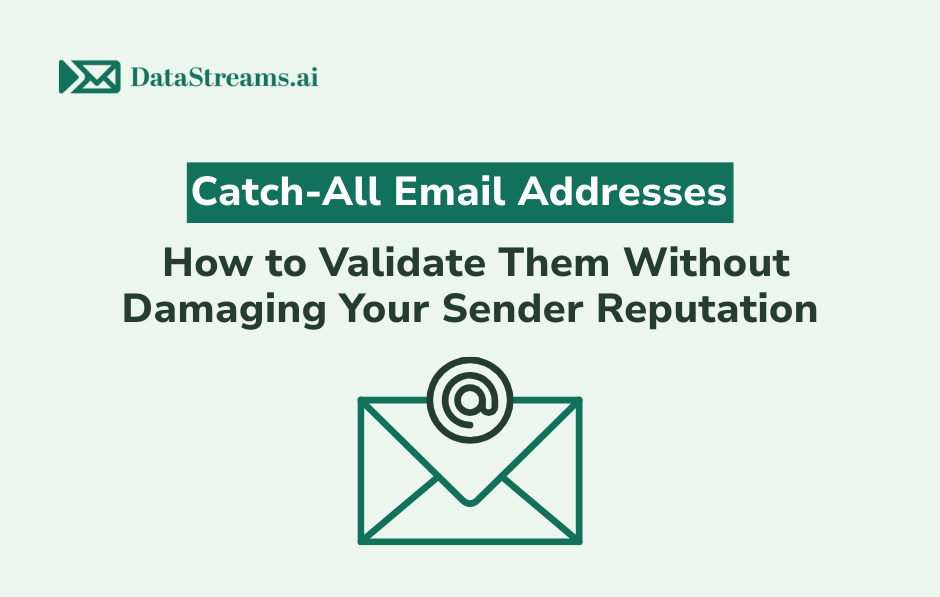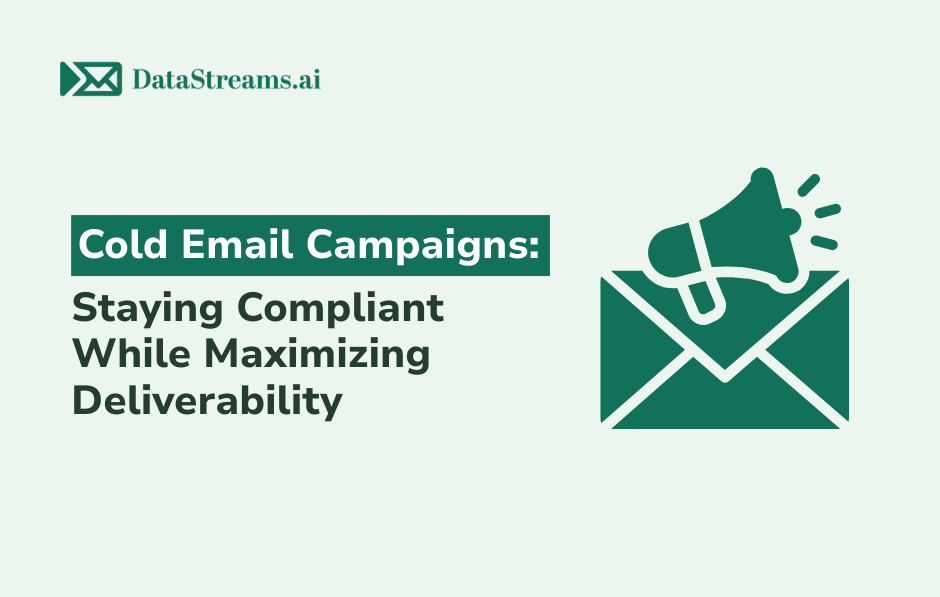Email marketing remains one of the highest ROI digital marketing channels, but the landscape has dramatically evolved. With stricter authentication requirements, AI-powered spam filters, and changing consumer expectations, email deliverability in 2025 requires a comprehensive, strategic approach that goes far beyond simply hitting “send.”
Table of Contents
- The New Email Deliverability Landscape
- 8 Critical Email Deliverability Trends for 2025
- Building a Full-Stack Email Deliverability System
- How DataStreams.ai Fits Into Your Strategy
- Best Practices for 2025 and Beyond
The New Email Deliverability Landscape
Email deliverability has transformed from a simple technical consideration into a complex ecosystem involving infrastructure, content optimization, artificial intelligence, and strict compliance requirements. Modern email service providers (ESPs) like Gmail, Outlook, and Yahoo now employ sophisticated machine learning algorithms that evaluate dozens of factors before determining whether your email reaches the inbox, promotions tab, or spam folder.
The stakes have never been higher. Poor deliverability doesn’t just mean lower open rates—it can permanently damage your sender reputation, leading to blacklisting and making it nearly impossible to reach your audience through email marketing campaigns.
8 Critical Email Deliverability Trends for 2025
1. Warm-Up Is Now Mandatory (1:1 Ratio Required)
The Old Way: Email warm-up was considered optional, and many marketers jumped straight into high-volume campaigns.
The New Reality: If you’re sending 100 cold emails per day, you now need 100 warm-up emails per day. This isn’t optional—it’s mandatory for maintaining sender reputation.
Email service providers have become increasingly sophisticated at detecting sudden volume spikes. A gradual warm-up process helps establish your domain and IP reputation as a legitimate sender. This process involves:
- Starting with small volumes (10-20 emails per day)
- Gradually increasing volume over 2-4 weeks
- Ensuring high engagement rates during warm-up
- Using authentic, personalized content during the warm-up phase
Impact on Deliverability: Skipping proper warm-up can result in immediate spam folder placement and long-term reputation damage that takes months to recover from.
2. Multi-Domain Strategy = Essential Risk Control
Why It Matters: Running multiple domains or subdomains isn’t just about scaling—it’s about protecting your entire email marketing operation.
Modern email deliverability requires a portfolio approach. If one domain experiences deliverability issues, your other domains remain protected. This strategy involves:
- Primary Domain: Your main business domain for transactional emails
- Marketing Domains: Dedicated domains for promotional campaigns
- Testing Domains: Domains for A/B testing and experimentation
- Geographic Domains: Region-specific domains for international campaigns
Implementation Strategy:
- Register domains that are closely related to your main brand
- Implement proper DNS settings (SPF, DKIM, DMARC) for each domain
- Maintain consistent branding across all domains
- Monitor reputation metrics for each domain separately
3. Authentication Protocols Are Non-Negotiable
The Big Four: SPF, DKIM, DMARC, and now BIMI (Brand Indicators for Message Identification) are becoming standard requirements.
What This Means:
- SPF (Sender Policy Framework): Specifies which servers can send email from your domain
- DKIM (DomainKeys Identified Mail): Adds a digital signature to verify email authenticity
- DMARC (Domain-based Message Authentication): Tells receiving servers what to do with emails that fail SPF or DKIM
- BIMI: Displays your brand logo in the inbox for authenticated emails
Critical Point: Even one missing authentication record significantly increases your spam risk. Major ESPs are increasingly rejecting emails that don’t meet these authentication standards.
4. List Hygiene: Your Insurance Policy Against Campaign Failure
The Reality Check: Bad data equals bounces, bounces equal spam classification, spam classification equals campaign death.
Email list hygiene in 2025 requires ongoing maintenance, not just one-time cleaning. Key components include:
Regular List Cleaning:
- Remove hard bounces immediately
- Monitor soft bounces and remove after 3-5 attempts
- Identify and remove spam traps
- Segment inactive subscribers for re-engagement campaigns
Quality Control Measures:
- Implement double opt-in processes
- Use real-time email validation during signup
- Monitor engagement metrics and remove non-responsive contacts
- Maintain bounce rates below 2% for optimal deliverability
This is where email validation services like DataStreams.ai become valuable – by allowing you to upload and verify your email lists, you can identify and remove problematic addresses before they impact your campaigns.
5. Testing Is Now Two-Phase: Pre-Send AND Post-Send
The Complete Testing Framework:
Pre-Send Testing:
- Seed testing with major ISPs
- Spam filter analysis
- Content and design testing
- Authentication verification
Post-Send Monitoring:
- Inbox placement tracking
- Blacklist monitoring
- Engagement rate analysis
- Delivery confirmation across different ESPs
This comprehensive testing approach helps identify and resolve deliverability issues before they impact your entire campaign.
6. AI Is Revolutionizing Email Operations
The AI Revolution in Email Marketing:
By 2026, 70% of email marketing teams will be AI-powered. Smart teams are already leveraging AI for:
Content Optimization:
- Subject line testing and optimization
- Personalization at scale
- Send time optimization
- Content A/B testing
Deliverability Management:
- Predictive deliverability scoring
- Automated list segmentation
- Real-time campaign optimization
- Anomaly detection for reputation management
Operational Efficiency:
- Automated email sequences
- Dynamic content generation
- Intelligent segmentation
- Performance analytics and reporting
7. Static Emails Are Becoming Obsolete
The Interactive Email Revolution:
Modern subscribers expect dynamic, engaging email experiences. Static emails are being replaced by:
Interactive Elements:
- Collapsible sections and accordions
- Embedded surveys and polls
- Interactive product carousels
- Real-time content updates
Benefits:
- Higher engagement rates
- Improved click-through rates
- Better inbox placement due to increased interaction
- Enhanced user experience
Implementation Considerations:
- Ensure fallback options for email clients that don’t support interactivity
- Test across multiple email clients and devices
- Monitor performance metrics to optimize interactive elements
8. Follow-Up Strategies Are Becoming More Sophisticated
The End of Spam-Heavy Sequences:
The old approach of 7-step email sequences with aggressive follow-ups is dead. Modern follow-up strategies focus on:
Quality Over Quantity:
- 2-3 high-quality emails spaced appropriately
- Quarterly recycling of non-responsive contacts
- Value-driven content in each touchpoint
- Personalized messaging based on recipient behavior
Behavioral Triggers:
- Website activity-based follow-ups
- Purchase behavior triggers
- Engagement-based segmentation
- Lifecycle stage-appropriate messaging
Building a Full-Stack Email Deliverability System
Email deliverability in 2025 requires integration across four key areas:
Infrastructure Layer
- Dedicated IP addresses
- Proper DNS configuration
- Authentication protocol implementation
- Multiple domain setup
Content Layer
- AI-optimized subject lines
- Personalized messaging
- Interactive design elements
- Mobile-responsive templates
Compliance Layer
- GDPR and privacy regulation adherence
- Subscription management
- Unsubscribe handling
- Data protection measures
Analytics Layer
- Real-time deliverability monitoring
- Engagement tracking
- ROI measurement
- Performance optimization
How DataStreams.ai Fits Into Your Strategy
DataStreams.ai’s email validation service addresses several critical components of this full-stack approach:
Comprehensive Email Validation
- Bulk file upload validation for existing email lists
- Individual email verification for quality checking
- Identifies problematic email addresses before sending campaigns
List Hygiene Support
- Helps clean existing email databases through file upload validation
- Supports maintaining the sub-2% bounce rate requirement
- Enables proactive list quality management
Flexible Validation Options
- Bulk processing capabilities for large email lists
- Single email verification for spot-checking
- Detailed validation reports to guide list management decisions
Compliance Assistance
- Helps maintain data quality standards
- Supports privacy regulation compliance
- Provides detailed reporting for audit purposes
Best Practices for 2025 and Beyond
1. Implement a Comprehensive Authentication Strategy
Set up SPF, DKIM, DMARC, and BIMI records for all sending domains. Regular monitoring and updates are essential as authentication requirements continue to evolve.
2. Develop a Multi-Domain Portfolio
Don’t put all your eggs in one basket. Establish multiple domains for different types of communications and maintain them separately.
3. Use Email Validation Services for List Quality
Services like DataStreams.ai allow you to upload and verify your email lists before campaigns, helping you identify and remove invalid addresses that could hurt your deliverability.
4. Create Interactive, Value-Driven Content
Move beyond static emails to create engaging experiences that encourage interaction and improve deliverability metrics.
5. Implement Continuous Monitoring
Set up systems to monitor deliverability metrics, sender reputation, and blacklist status in real-time.
6. Focus on Quality Metrics
Prioritize engagement rates, conversion rates, and long-term subscriber value over volume metrics.
7. Stay Informed About Industry Changes
Email deliverability requirements continue to evolve. Stay updated on new regulations, ESP policy changes, and industry best practices.
Conclusion
Email deliverability in 2025 is no longer about checking boxes—it’s about building a comprehensive system that addresses infrastructure, content, compliance, and analytics in an integrated way. The organizations that succeed will be those that view email deliverability as a strategic advantage rather than a technical hurdle.
The investment in proper email deliverability infrastructure, including quality validation services like DataStreams.ai, will continue to pay dividends as the ecosystem becomes increasingly sophisticated. The question isn’t whether you can afford to implement these strategies—it’s whether you can afford not to.
By following these guidelines and staying ahead of industry trends, you’ll not only achieve better inbox placement in 2025 but also build a sustainable email marketing program that delivers long-term results.
Ready to improve your email deliverability? Start with the foundation—clean your email lists with DataStreams.ai's email validation service. Upload your lists for comprehensive verification, or verify individual emails to maintain list quality. Clean lists lead to better deliverability, higher engagement, and stronger ROI.

